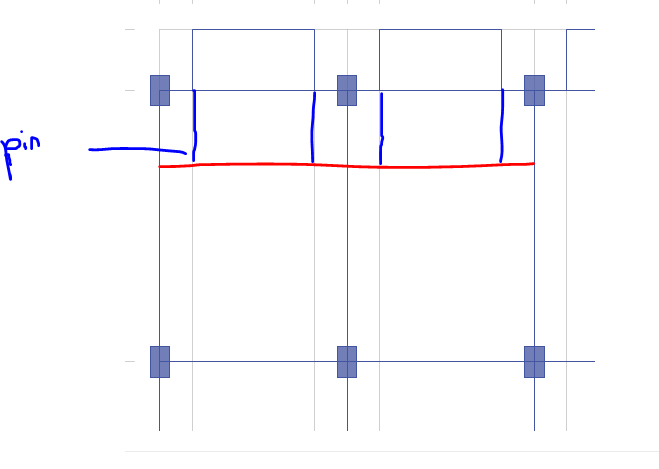-
Posts
1470 -
Joined
-
Last visited
-
Days Won
446
Content Type
Profiles
Forums
Events
Everything posted by UmarMakhzumi
-
Attached is another solution. You can add new beams. Red and Blue. The end condition for Red beams can be pinned/ moment released. For Blue, the end towards the red beam can be pinned/ moment released only. The size of blue beam should be same as balcony beam. Thanks.
-
Wsalaam WR WB, Welcome aboard Fikri. We are very pleased to have you. Thank you.
-
The situation here is very similar to where foundations are placed on steel piles (although there is no continuity for piles to top like columns can have another column on top of slab). I can explain to you what is done for the pile connection. Normally a cap plate is used on top of the pile and dowels are welded to the cap plate that get embedded in the foundation concrete. The dowels can be designed for shear and tension forces (Moment is resolved into tension). I haven't done a configuration in slab but for piles, I have done a lot of these. Regards, Makhzumi.
-

Energy/ virtual work diagram in etabs
UmarMakhzumi replied to Aye Min Khaing's topic in Software Issues
This is a very powerful feature and a great question asked. Please see the following video: Thanks. -
I would suggest reading this book, as it has a lot of case studies on famous high rise buildings. Structural Analysis and Design of Tall Buildings: Steel and Composite Construction - 1st Edition
- 5 replies
-
- structural analysis
- structural design
-
(and 1 more)
Tagged with:
-

Co-efficient Method of Slab Design and Beam Stiffness
UmarMakhzumi replied to Ali Shan's topic in Concrete Design
You need to create a new topic to be consistent with Forum Posting Guidelines. We have a lot of people on forum that are experienced with SAFE. They will answer. Thanks. Makhzumi! -
One of the biggest life lessons that I have learned is on focusing what not to do, rather than focusing on what to do. As the great Molana Rumi said, The art of knowing is to know what to ignore. I would suggest you to read about structural failures as that will shift your thinking to what should not be done. A good starting book would be - Why Structures Fall Down. Thanks. Makhzumi!
- 5 replies
-
- structural analysis
- structural design
-
(and 1 more)
Tagged with:
-

Co-efficient Method of Slab Design and Beam Stiffness
UmarMakhzumi replied to Ali Shan's topic in Concrete Design
Ali, I will need to dig up the reference but I think what I read a few years ago, if my memory serves me right is that beams need to be twice as stiff as slabs. Thanks. -
From the website, where you can download this as well fo free. DOCUMENT DETAILS Publication Year: 2015 Pages: 31 ISBN: Formats: PDF TABLE OF CONTENTS Design Aid J.1-1 Areas of Reinforcing Bars Design Aid J.1-2 Approximate Bending Moments and Shear Forces for Continuous Beams and One-way Slabs Design Aid J.1-3 Variation of φ with Net Tensile Strain in Extreme Tension Steel εt and c / dt – Grade 60 Reinforcement and Prestressing Steel Design Aid J.1-4 Simplified Calculation of As Assuming Tension-Controlled Section and Grade 60 Reinforcement Design Aid J.1-5 Minimum Number of Reinforcing Bars Required in a Single Layer Design Aid J.1-6 Maximum Number of Reinforcing Bars Permitted in a Single Layer Design Aid J.1-7 Minimum Thickness h for Beams and One-Way Slabs Unless Deflections are Calculated Design Aid J.1-8 Reinforcement Ratio ρt for Tension-Controlled Sections Assuming Grade 60 Reinforcement Design Aid J.1-9 Simplified Calculation of bw Assuming Grade 60 Reinforcement and ρ = 0.5 ρmax Design Aid J.1-10 T-beam Construction Design Aid J.1-11 Values of φVs = Vu - φVc (kips) as a Function of the Spacing, s Design Aid J.1-12 Minimum Shear Reinforcement Av, min / s Design Aid J.1-13 Torsional Section Properties Design Aid J.1-14 Moment of Inertia of Cracked Section Transformed to Concrete, Icr Design Aid J.1-15 Approximate Equation to Determine Immediate Deflection, Δi, for Members Subjected to Uniformly Distributed Loads Design Aids J.2 Two-Way Slabs – Direct Design method, includes the following: - Conditions for Analysis by the Direct Design Method - Definitions of Column Strip and Middle Strip - Definition of Clear Span, - Design Moment Coefficients used with the Direct Design Method - Effective Beam and Slab Sections for Computation of Stiffness Ratio, αf - Computation of Torsional Stiffness Factor, βt, for T- and L-Sections - Moment Distribution Constants for Slab-Beam Members without Drop Panels - Stiffness and Carry-Over Factors for Columns
-
Normally what I have seen is that almost all Client Specifications require buoyancy checks to be done assuming GWT is at grade irrespective of where it is (to account for seasonal fluctuations and also because the approach is conservative). You only need to consider buoyancy for the volume of concrete that is displacing the water (assuming water table is at grade). For soil, you will have submerged unit weight that accounts the buoyancy affects. Thanks.
-

Improve Bearing Capacity of Soil
UmarMakhzumi replied to Muhammad Ameen Ali's topic in Concrete Design
You are better off using a different foundation system if your bearing capacity is super low than expected. Have you considered piling? You can use friction piles if loads are low. Thanks. -
Built up sections are custom sections. You are better off adding plates to increase the capacity to meet the demand. Trial and error. Thanks.
-

Structural Design Codes in Pakistan?
UmarMakhzumi replied to Simple Structures's topic in General Discussion
This is a great question. I will share what I have been using: In addition to above, I once got the chance to use Eurocode for a British Embassy Project but that was exception to the rule. Pakistan should work on improving it's own code. We would be better off improving on American codes as people are more familiar with them. I think you can get contact information on this if you have a copy of Pakistan Building Code. please see the following link for more details: https://www.pec.org.pk/building_code_pakistan.aspx It would be great to see what others have been using in Pakistan. Thanks. -
Hi Rummaan17, Great questions. This can happen. However, just to keep things simple you can size your section to make sure bending resistance is > than shear resistance. I know this answer is not very neat but I have been out of touch with this so don't exactly remember the details here. You might have to refresh me here about where does this come in play? I think the example that I have provided only talks about the period calculation, not the strength. You are right. Do you have a criteria provided by the Client company to meet? There might be details there about what load combinations to use and what checks need to be done for blast loading for strength design. Could be, but I haven't done it. You have got some excellent questions here. I wish I could answer you better but to be honest, blast loading is a complete criteria in itself. Normally a good starting point would be client specifications that you have to meet as they should specify they load cases, acceptance limit states under strength and serviceability and any other items that need to be considered. If you don't have a governing criteria, then the next best thing would be to get a book on the subject and follow a design example and establish the limit sates. Let me know. Thanks.
-
Welcome aboard Syahrul, We are very happy to have you here. Thanks.
-
Wsalaam Fatima, Definition of Storey is based on if a diaphragm is provided or not. So for cases, where there is a concrete moment resisting frame system, that has a steel truss roof, if the roof has sufficient horizontal bracing (which is normally the case or the structure would be unstable), then it will act as diaphragm, and you can consider that construction up to roof as one story and any extensions above as another storey. Now for cases where you have concrete column extending a bit from roof and steel columns are used, in my opinion (I could be wrong as I am out of touch from seismic since long), you can simply your design by still assuming 2 stories, one till steel roof and other to top of new construction, and design the connection between steel and concrete column with using over strength factors. This is the most simple answer I could give you without looking at the sketch. Thanks.
-
Yes, please scale it down.
- 22 replies
-
- Dynamic Analysis Example
- Response Spectrum
-
(and 1 more)
Tagged with:
-
The question is very general and there can be numerous answers. You can try different layout of beams to see which one way direction provides the least quantity of reinforcement and concrete volume. These values would be based on applied loads so discussing these parameters is open ended. Thanks.
-
Earthquake loads as generally considered in one direction at a time (unlike wind). There are some exceptions to it like when you have a non-orthogonal system. The requirements on condition where you have to consider earthquake loads simultaneously in both directions are generally provided in the building code that you are following. So, I would recommend you to look up your building code. If your question is about a regular Seismic Lateral Frame Resisting System, then, the answer is to consider one direction at one time. P+Myy and P+ Mxx ( Check for both cases independently) Thanks.
-
Good question. For further details please see: https://teklastructures.support.tekla.com/2016/en/int_sap2000 Thanks.
-

Reinforcement Overrides for Ductile Beams
UmarMakhzumi replied to Maleeha Joohi's topic in Software Issues
The posted video above by Ayesha answers the question. Thanks. -
You can look up the code that you are designing too and it lists down all the irregularities that require RSA. There is a topic on this forum that explains how to do RSA in ETABS. See the following: Depends on layout to layout and what are you trying to avoid. For example to control torsion, shear walls need to be located as far from the center of mass as possible. Thanks.
-
Sleeves are common. General engineering practice is to place them at location of least moment along the span. You can get that location from your structural analysis software. Once you have located the sleeve, you need to make sure that you satisfy the shear and flexural strength of the beam at that location. Thanks.
-

dynamicanalysis Structural Dynamics
UmarMakhzumi replied to HAMMAD BASHIR's topic in General Discussion
You need to check a reference code like AASHTO or talk to Client to see what specifications they want you to use to determine these factors. -
Great, some real useful information added here. Thanks.
- 4 replies
-
- beam-column joint
- sefp consistent design
-
(and 1 more)
Tagged with:



